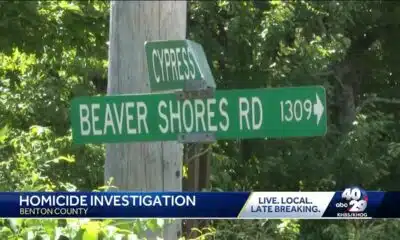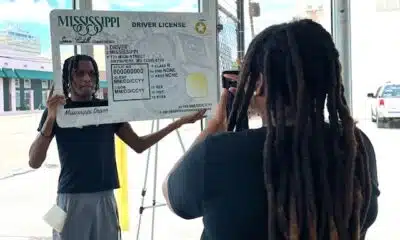News from the South - Kentucky News Feed
Samuel Crawford fought for freedom
Samuel Crawford fought for freedom
by Berry Craig, Kentucky Lantern
February 24, 2025
Samuel Crawford, one of approximately 24,000 Black Kentuckians who fought for their freedom and helped save the Union, is buried in virtual anonymity in Mayfield’s Oak Crest Cemetery.
The Civil War veteran rests for eternity under a ramrod-straight military tombstone at the foot of a towering oak tree. “CO. I 4 U.S. CLD. HV. ARTY.” is chiseled on the white marble slab in the historically African American burial ground. The abbreviations mean that Crawford was in Company I of the Fourth United States Colored Heavy Artillery.
The Fourth Artillery was recruited in Columbus, a strategic Mississippi River port on the western edge of the Jackson Purchase, Kentucky’s westernmost region.
In 1861, the Confederates turned the Hickman County town into a cannon-bristling bastion they dubbed the “Gibraltar of the West.” But by early the next year, Hickman County was under Union occupation and remained there until the war’s end in 1865. Columbus became a haven for escaped slaves and the state’s second-largest African American recruit training center. Only Camp Nelson in Jessamine County was larger. (Some of the Columbus earthworks, trenches and a large anchor and part of a heavy chain the rebels used to block the river are preserved in Columbus-Belmont State Park.)
About 179,000 Black volunteers, most of them slaves, served in the Union forces, prompting President Abraham Lincoln to declare in 1865, “without the military help of the black freedmen, the war against the south could not have been won.”
Even so, for decades after the Civil War, almost all white historians ignored or downplayed the key role Black soldiers played in Union victory. Modern historians have done much to correct the omissions and distortions.
Yet some Confederate apologists continue to claim falsely that thousands of Black men fought in rebel gray, though Confederate government officials hotly denied any such thing. “Not only would no slaves be enlisted; no one who was not certifiably white, whether slave or free, would be permitted to become a Confederate soldier,” wrote historian Bruce Levine in the Washington Post.
(In March, 1865, a month before Gen. Robert E. Lee’s surrender at Appomattox, Virginia, the Confederate government, desperate to stave off defeat, authorized Black enlistment. The plan triggered strong opposition and few Black enlistees signed up. Levine wrote that, revealingly, neither rebel President Jefferson Davis or anybody else who touted the plan “ever pointed proudly to the record of any of the Black units (or even individuals) who purveyors of the modern myth claim were already in the field.”)
Promoters of the “Black Confederate Myth” wanted “to demonstrate that if free and enslaved Black men fought in Confederate ranks, the war could not have been fought to abolish slavery,” wrote Kevin M. Levin in “Searching for Black Confederates: The Civil War’s Most Persistent Myth.”
“Stories of armed black men marching and fighting would make it easier for the descendants of Confederate soldiers and those who celebrate Confederate heritage to embrace their Lost Cause unapologetically without running the risk of being viewed as racially insensitive or worse,” Levin writes.
The U.S. military was segregated in the Civil War. White officers commanded Black units, which were officially United States Colored Troops, USCT for short.
Kentucky was a border state that spurned secession. But making soldiers of slaves enraged almost all white Kentuckians, including most of the strongest Unionists. The Louisville Journal, the state’s premier Union newspaper, argued that Blacks and whites “cannot exist in the same country unless the black race is in slavery.”
In short, most Unionist Kentuckians were pro-slavery and pro-Union. (The state’s Confederate minority claimed only secession could save slavery.)
Reflecting the sentiment of pro-Union Kentuckians, Frankfort refused to allow “Kentucky” attached to the name of any Black unit raised in the state.
Black troops incensed Confederate soldiers who were fighting to establish an independent Southern nation rooted in slavery and white supremacy. The Confederates considered Black soldiers in the Union army rebellious slaves.
“Throughout the war, USCT regiments faced a danger that their white peers did not: re-enslavement or execution,” says the Museum of the U.S. Army’s website. “Official Confederate policy refused to recognize African Americans as lawful combatants. Any captured African American Soldiers or their white officers were subject to harsh treatment or execution.”
There were massacres of Black troops. In April, 1864, “Confederate soldiers under the command of Maj. Gen. Nathan B. Forrest executed wounded and captured USCT men after the battle of Fort Pillow, in Henning, Tennessee,” the website says.
Black soldiers also faced hostile civilians statewide, but especially in the Purchase, the state’s only Confederate-majority region.
Though the Columbus soldiers were trained as artillerymen, they were mainly used as infantry, patrolling, fighting gorillas and rebel raiders and guarding outlying roads, bridges and rail lines. At Columbus, they helped white troops guard the post, unload steamboats and load rail cars. White officers praised their conduct under fire.
The Fourth Artillery mustered out of federal service in 1866.
Crawford’s headstone doesn’t reveal his lifespan. His birth date is evidently unknown, but he was almost certainly born in bondage. Crawford died on Jan. 3, 1895, during the segregationist Jim Crow era when race discrimination was the law in the South and border states like Kentucky and was underpinned by violence or the threat of violence.
In Jim Crow times, separate-and-unequal status for Black Americans didn’t end when life did. Oak Rest is downhill from then white-only Maplewood Cemetery, where the main entrance gateway is a 1924 memorial to local Confederate soldiers.
Kentucky Lantern is part of States Newsroom, a nonprofit news network supported by grants and a coalition of donors as a 501c(3) public charity. Kentucky Lantern maintains editorial independence. Contact Editor Jamie Lucke for questions: info@kentuckylantern.com.
The post Samuel Crawford fought for freedom appeared first on kentuckylantern.com
News from the South - Kentucky News Feed
Soaking rains finally moving out tonight
SUMMARY: Soaking rains brought flooding to Southern Indiana, especially Clark and Washington counties, with some areas receiving up to two inches of rain. Flash flood warnings were extended until 12:15 a.m. due to continued rainfall. While storms will taper off overnight, scattered showers and storms are expected each afternoon through Monday, with the strongest activity near the parkways. Temperatures will remain in the upper 80s to low 90s, with patchy fog possible in the mornings. Drier weather is forecast by midweek, but that will bring rising temperatures into the mid-90s and heat indices climbing well into the triple digits.
WLKY meteorologist Eric Zernich’s Thursday night forecast
Subscribe to WLKY on YouTube now for more: http://bit.ly/1e5KyMO
Get more Louisville news: http://www.wlky.com
Like us: http://www.facebook.com/wlkynews
Follow us: http://twitter.com/WLKY
Instagram: https://www.instagram.com/wlky/
News from the South - Kentucky News Feed
Morgantown resident throws first pitch at Great American Ballpark
SUMMARY: Butler County native Jason Mode, who has worked 14 years at McCormick Equipment, was honored to throw the first pitch at Great American Ballpark on July 12 before the Cincinnati Reds game against the Colorado Rockies. Mode, a baseball enthusiast with both children playing for the Butler County Bears, found the moment especially meaningful after his son’s recent emergency eye surgery. Despite being selected from 300 employees, Mode felt the day was surreal and unforgettable. He hopes to return someday to pitch while his son or daughter catches, treasuring the family connection to the sport and this once-in-a-lifetime opportunity.
The post Morgantown resident throws first pitch at Great American Ballpark appeared first on www.wnky.com
News from the South - Kentucky News Feed
2 new candidates — a physician politician and former federal prosecutor — enter US House race
by McKenna Horsley, Kentucky Lantern
July 17, 2025
Kentucky’s race for an open U.S. House seat got two new candidates — one from each party — Thursday morning.
Republican Dr. Ralph Alvarado, a former Kentucky lawmaker, and Democrat Zach Dembo, a former federal prosecutor, announced they’re running.
Alvarado has been Tennessee’s health commissioner since 2023, a post he held until recently announcing that he was considering a run for Congress from Kentucky.
The two new candidates bring the field to six, three from each party. The 6th Congressional District seat is up for grabs because its current holder, Republican Andy Barr, is running for U.S. Senate in hopes of succeeding Republican Mitch McConnell, retiring after seven terms.
Democrat Cherlynn Stevenson, a former Kentucky House Democratic caucus chair, has gained an early fundraising lead according to recent campaign finance reports. David Kloiber, a former Lexington council member, is also running for the Democratic nomination.
Alvarado joins Republicans state Rep. Ryan Dotson who announced his campaign earlier this year and state Rep. Deanna Gordon who launched her bid last week.
The primary election will be held in May 2026.
Alvarado: ‘Shoulder to shoulder with President Trump’
In his announcement, Alvarado, a physician, said he would “stand shoulder to shoulder with President Trump in Washington, to secure the border, revive the economy, and put America first.”
Alvarado describes himself as “a proud son of immigrants and a relentless defender of the American Dream.”
He said Trump is “under attack from every direction, and he needs reinforcements in Congress.”
Alvarado said in Congress he would “fight to lower healthcare costs, save rural hospitals, and stop illegal immigrants from abusing Medicaid,” as well as fight for Kentucky’s signature industries “including bourbon, thoroughbred horse racing and manufacturing.”
Alvarado was born in California, the son of a father from Costa Rica and mother from Argentina.
He became Kentucky’s first Hispanic legislator after unseating incumbent Democrat R.J. Palmer in a 2014 state Senate race from a district made up of Clark and parts of Fayette and Montgomery counties.
Alvarado spoke at the 2016 Republican National Committee in support of Trump. He was Republican Gov. Matt Bevin’s running mate in Bevin’s losing 2019 bid for reelection.
In his farewell speech to the Senate in January 2023, he said, “I love solving problems. … Work is play for me. When I wake up, my mind clicks and I can’t really turn it off until I go to bed. When I am in social gatherings with many of you, I pursue discussions about policy. Some of you have said, ‘Ralph, let it go. We’re not on the clock.’ The problem is that I’m always on the clock. I have a really hard time turning it off. It’s both a blessing and a curse.”
Tennessee’s Republican Gov. Bill Lee appointed Alvarado commissioner of the Tennessee Department of Health. He recently left the Tennessee post after saying he likely would run for Congress from Central Kentucky in response to state Sen. Amanda Mays Bledsoe’s announcement that she would not be seeking the seat.
In his announcement, Alvarado said he and his wife, Dawn, still live in Clark County where they raised their two children and are “active members of their church and community.”
Dembo: ‘D.C. corruption getting in the way of helping folks in Kentucky’
A former federal prosecutor and staffer for Gov. Andy Beshear, Dembo, a Lexingtonian, left his job as an assistant U.S. attorney in the Department of Justice earlier this year amid Trump’s return to the White House.
“I couldn’t stand by while the administration was playing politics with the justice system to carry out a personal political agenda instead of protecting the Constitution,” Dembo said in a telephone interview with the Kentucky Lantern. “And I felt like D.C. corruption was getting in the way of helping folks in Kentucky. So I wanted to continue serving my country, but obviously my public service had to take a different path, and that’s why I’m running for Congress now.”
Dembo previously worked in the U.S. Department of Justice during the first Trump administration, but said that “while there were many things I disagreed with, personally and politically, I still felt that everyday line prosecutors were able to do their job at DOJ.”
In February, several federal prosecutors resigned after being directed to drop charges in a corruption case against New York Mayor Eric Adams. More recently, Reuters reported earlier this week that 69 of the roughly 110 lawyers in the DOJ’s federal programs branch, which is tasked with defending legal challenges to the president’s policies, have left the unit since Trump’s recent election or plan to leave.
“This second administration, as we’ve seen through many publicly reported things, is not the same,” Dembo said, adding that “prosecutors are being asked to do things that are immoral, unethical” and facing being fired if they do not go along with it.
In addition to his decision to leave the DOJ, Dembo also has concerns about the recently passed GOP megabill, which included cuts to Medicaid and Supplemental Nutrition Assistance Program funding. Barr voted in favor of the bill, and has supported other Trump policies as he seeks the Republican nomination for U.S. Senate.
“The current congressman is voting very enthusiastically in favor so that he can give tax breaks to his rich buddies and coastal elites, which, again, that’s just not the Kentucky values I was raised with,” Dembo said of Barr.
Dembo plans to distinguish himself from his opponents by focusing on his background as a Navy veteran and federal service. However, he said he is “clear-eyed” that voters may not know him at present. But he remains optimistic that his background in public service, in Kentucky and the district will “connect with voters.”
“Certainly that’s going to be an uphill battle with maybe the name ID, but at the same time, I think it’s a real advantage at a time where people are looking for new and fresh ideas, so I will definitely be looking simply to add to the conversation, not to tear anyone down,” Dembo said.
Dembo has taken some lessons from Beshear. The governor named Dembo as his policy adviser in 2020. Dembo was later promoted to become Beshear’s legislative director.
“Something that I learned from Gov. Beshear is that I don’t think that Kentuckians primarily are waking up thinking about who they vote for or what party they’re registered. I think they’re worried about their families and how they can be successful and have a good paying job and make ends meet,” Dembo said.
“So that’s very much how I’m going to approach it, and it’s not going to be as important to me what party someone identifies with, because if I’m lucky enough to get elected, I’m going to represent all of them.”
This story was updated early Thursday morning to include Republican Ralph Alvarado’s announcement.
Kentucky Lantern is part of States Newsroom, a nonprofit news network supported by grants and a coalition of donors as a 501c(3) public charity. Kentucky Lantern maintains editorial independence. Contact Editor Jamie Lucke for questions: info@kentuckylantern.com.
The post 2 new candidates — a physician politician and former federal prosecutor — enter US House race appeared first on kentuckylantern.com
Note: The following A.I. based commentary is not part of the original article, reproduced above, but is offered in the hopes that it will promote greater media literacy and critical thinking, by making any potential bias more visible to the reader –Staff Editor.
Political Bias Rating: Centrist
This content provides a balanced overview of the candidates running for the open U.S. House seat in Kentucky’s 6th Congressional District, presenting both Republican and Democratic perspectives. The piece includes factual information, campaign announcements, and quotes from candidates across the political spectrum, without emphasizing or favoring either party. The reporting highlights differences in policy stances and backgrounds while maintaining a neutral tone, typical of centrist political coverage aimed at informing voters rather than persuading them.
-
News from the South - Tennessee News Feed5 days ago
Bread sold at Walmart, Kroger stores in TN, KY recalled over undeclared tree nut
-
News from the South - Arkansas News Feed7 days ago
Man shot and killed in Benton County, near Rogers
-
News from the South - Georgia News Feed1 day ago
Aiken County family fleeing to Mexico due to Trump immigration policies
-
News from the South - Alabama News Feed6 days ago
Girls Hold Lemonade Stand for St. Jude Hospital | July 12, 2025 | News 19 at 10 p.m. – Weekend
-
News from the South - Georgia News Feed7 days ago
Anti-ICE demonstrators march to Beaufort County Sheriff's Office
-
News from the South - Oklahoma News Feed7 days ago
Police say couple had 50+ animals living in home
-
Mississippi Today4 days ago
Coast judge upholds secrecy in politically charged case. Media appeals ruling.
-
Mississippi Today1 day ago
Driver’s license office moves to downtown Jackson









































